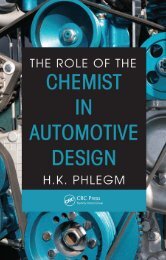Lightweight Electric/Hybrid Vehicle Design
Lightweight Electric/Hybrid Vehicle Design
Lightweight Electric/Hybrid Vehicle Design
You also want an ePaper? Increase the reach of your titles
YUMPU automatically turns print PDFs into web optimized ePapers that Google loves.
About the authors<br />
Preface ix<br />
Electro-technology author Ron Hodkinson is very actively involved in the current value<br />
engineering of automotive fuel-cell drive systems through his company Fuel Cell Control Ltd and<br />
is particularly well placed to provide the basic electro-technology half of this work. He obtained<br />
his first degree in electrical engineering (power and telecommunications) from the Barking campus,<br />
of what is now the University of East London, on a four-year sandwich course with Plessey. At the<br />
end of the company’s TSR2 programme he moved on to Brentford <strong>Electric</strong> in Sussex where he<br />
was seconded on contract to CERN in Switzerland to work on particle-accelerator magnetic power<br />
supplies of up to 9 MW. He returned to England in 1972 to take a master’s degree at Sussex<br />
University, after which he became Head of R&D at Brentford <strong>Electric</strong> and began his long career in<br />
electric drive system design, being early into the development of transistorised inverter drives. In<br />
1984 the company changed ownership and discontinued electronics developments, leading Ron<br />
to set up his own company, Motopak, also developing inverter drives for high performance machine<br />
tools used in aircraft construction. By 1989 his company was to be merged with Coercive Ltd who<br />
were active in EV drives and by 1993 Coercive had acquired Nelco, to become the largest UK<br />
producer of EV drives. In 1995 the company joined the Polaron Group and Ron became Group<br />
Technical Director. For the next four years he became involved in both machine tool drives and<br />
fuel cell controls. In 1999 the group discontinued fuel-cell system developments and Ron was<br />
able to acquire premises at Polaron’s Watford operation to set up his own family company Fuel<br />
Cell Control Ltd, of which he is managing director. He has been an active member of ISATA<br />
(International Society for Automotive Technology and Automation) presenting numerous papers<br />
there and to the annual meetings of the EVS (<strong>Electric</strong> <strong>Vehicle</strong> Seminar). He is also active in the<br />
Power Electronics and Control committees of the Institution of <strong>Electric</strong>al Engineers. Some of his<br />
major EV projects include the Rover Metro hybrid concept vehicle; IAD electric and hybrid vehicles;<br />
the SAIC fuel-cell bus operating in California and Zetec taxicabs and vans.<br />
Co-author John Fenton is a technology journalist who has plotted the recent course in EV<br />
design and layout, including hybrid-drive vehicles, in the second half of the book, which also<br />
includes his chapters on structure and systems design from his earlier industrial experience. He is<br />
an engineering graduate of the Manchester University Science Faculty and became a member of<br />
the first year’s intake of Graduate Apprentices at General Motors’ UK Vauxhall subsidiary. He<br />
later worked as a chassis-systems layout draughtsman with the company before moving to<br />
automotive consultants ERA as a chassis-systems development engineer, helping to develop the<br />
innovative mobile tyre and suspension test rig devised by David Hodkin, and working on runninggear<br />
systems for the Project 378 car design project for BMC. With ERA’s subsequent specialization<br />
on engine systems, as a result of the Solex acquisition, he joined the Transport Division of Unilever,







